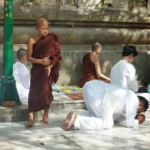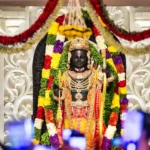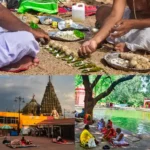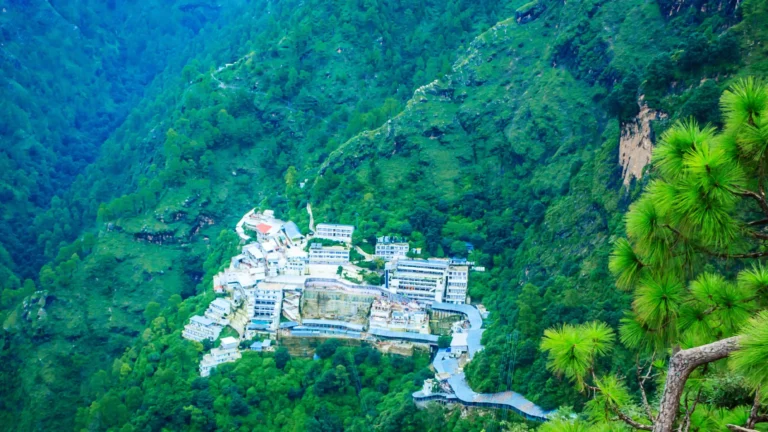Somnath Temple, Gujarat: The Eternal Shrine of Resilience and Faith – Temples of India
Introduction – Temples of India
Situated along the western coast of Gujarat, the Somnath Temple is a symbol of unyielding faith and spiritual resilience. As one of the 12 Jyotirlingas of Lord Shiva, the temple holds a special place in Hindu mythology and is a significant pilgrimage destination.
Known for its rich history, architectural grandeur, and spiritual significance, the Somnath Temple is a must-visit for anyone interested in Indian spirituality and culture.
Significance
The Somnath Temple is dedicated to Lord Shiva and is one of the 12 Jyotirlingas, making it a pivotal center for Shaivism. According to Hindu mythology, the temple was originally built by the Moon God after Lord Shiva cured him of leprosy. The temple is also famous for its resilience, having been destroyed and rebuilt several times throughout history.

Architectural Style
The current structure, built in the Chalukya style of architecture, was completed in 1951. The temple features a grand Sabha Mandap (assembly hall) and a tall, imposing Shikhar (spire) that stands as a testament to ancient Indian architecture and craftsmanship. Intricate carvings and sculptures adorn the temple, adding to its aesthetic and spiritual allure.
Best Time to Visit
The ideal time to visit the Somnath Temple is from October to March when the weather is pleasant. The temple also hosts various festivals and events throughout the year, with Maha Shivaratri being the most prominent.
Unique Features
What sets the Somnath Temple apart is its history of resilience. The temple has been destroyed and rebuilt several times, most recently in 1951. Each reconstruction stands as a testament to the unyielding faith of its devotees. The temple complex also houses a museum that showcases the temple’s history and the various phases of its reconstruction.
Rituals and Ceremonies
The temple follows traditional Hindu rituals. The day begins with the Mangala Aarti in the early morning and concludes with the Shayan Aarti at night. Throughout the day, various offerings and rituals like Abhishekam and Archana are performed. Devotees can participate in these rituals and gain a deeper understanding of Hindu worship practices.
Why Visit?
Spiritual Significance: Being one of the 12 Jyotirlingas, the temple holds immense spiritual importance and is believed to bestow blessings and prosperity.
Architectural Marvel: The temple is a masterpiece of Chalukya architecture, featuring intricate carvings and a grand spire.

Historical Importance: The temple’s history of resilience makes it a symbol of enduring faith and spiritual strength.
Cultural Experience: The temple rituals and ceremonies offer a glimpse into the rich tapestry of Hindu religious practices.
Conclusion
The Somnath Temple is not just a religious site but a living testament to the enduring faith and resilience of human spirituality. Its rich history, stunning architecture, and the deep sense of devotion that one experiences here make it a must-visit for anyone interested in spirituality, history, or architecture.
Whether you are a devout follower, a history enthusiast, or a curious traveller, a visit to the Somnath Temple is sure to leave you spiritually enriched and culturally enlightened.
Meenakshi Amman Temple, Tamil Nadu: A Labyrinth of Art, Culture, and Spirituality – Temples of India
Introduction – Temples of India
Located in the temple city of Madurai in Tamil Nadu, the Meenakshi Amman Temple is an epitome of Dravidian architecture and a significant spiritual centre for Hindus. Dedicated to Goddess Meenakshi and her consort, Lord Sundareswarar (Shiva), the temple is a sprawling complex that captivates visitors with its intricate carvings, towering gateways, and vibrant festivals.
This guide aims to explore the multifaceted aspects of the Meenakshi Amman Temple, making it a must-visit for anyone interested in Indian spirituality and culture.
Significance
The temple is primarily dedicated to Goddess Meenakshi, considered an avatar of Goddess Parvati. According to legend, Meenakshi was born with three breasts and it was prophesied that the extra breast would disappear when she met her future husband. This came true when she met Lord Sundareswarar, an incarnation of Lord Shiva. The temple celebrates their divine union and is a significant center for the worship of the Goddess in her various forms.

Architectural Style
The Meenakshi Amman Temple is a masterpiece of Dravidian architecture, characterized by its towering gopurams (temple towers) adorned with thousands of colourful stone figures and carvings. One of the most remarkable features is the Hall of a Thousand Pillars, where each pillar is uniquely carved and produces a different musical note when struck.
Best Time to Visit
The best time to visit the temple is between December and April when the weather is pleasant. The temple is also the centre for the annual Meenakshi Thirukalyanam festival, usually held in April, which is a grand celebration attracting devotees and tourists alike.
Unique Features
Apart from its architectural grandeur, the temple is also known for its Golden Lotus Tank, a sacred pond within the temple complex where devotees take a dip for spiritual cleansing. The temple also has a grand bazaar within its premises, offering a range of religious artefacts, jewellery, and South Indian handicrafts.
Rituals and Ceremonies
The temple follows a rigorous schedule of rituals and ceremonies, starting from the early morning prayers to the late-night processions. Special rituals like “Meenakshi Thirukalyanam,” the celestial wedding of the deities, are conducted during the annual festival, offering a unique spiritual experience.
Why Visit?
Architectural Brilliance: The temple is a marvel of Dravidian architecture, featuring intricate carvings, towering gopurams, and a hall with a thousand uniquely carved pillars.
Spiritual Atmosphere: The temple radiates a deeply spiritual aura, amplified by hymns, rituals, and the devotion of the pilgrims.

Cultural Insight: The temple offers a deep dive into Tamil culture, art, and religious practices, making it a holistic experience.
Festive Celebrations: The annual Meenakshi Thirukalyanam festival is a spectacle of grand processions, elaborate rituals, and cultural performances.
Conclusion
The Meenakshi Amman Temple is not just a religious site but a spiritual and cultural extravaganza. Its architectural splendour, the fervour of its rituals, and its cultural significance make it a must-visit destination. Whether you are a spiritual seeker, an art lover, or a cultural enthusiast, the Meenakshi Amman Temple offers an enriching experience that transcends religious boundaries.
Jagannath Temple, Odisha: A Journey into the Heart of Divine Love and Devotion – Temples of India
Introduction – Temples of India
Located in the coastal town of Puri in Odisha, the Jagannath Temple is one of the most revered and ancient temples in India. Dedicated to Lord Jagannath, an incarnation of Lord Vishnu, the temple is one of the Char Dhams—four sacred pilgrimage sites in India.
Known for its grand annual Rath Yatra (Chariot Festival), the temple is a melting pot of devotion, culture, and ancient rituals. This guide aims to explore the various facets that make the Jagannath Temple a must-visit spiritual destination.
Significance
The Jagannath Temple is dedicated to Lord Jagannath, his sister Subhadra, and his brother Balabhadra. The deities are unique as they are made of wood and are replaced every 12 to 19 years, a ritual known as ‘Nabakalebara.’ The temple is considered a powerful center of Bhakti (devotional) yoga, and it attracts millions of devotees each year.

Architectural Style
The temple is a classic example of Kalinga architecture, featuring intricately carved stone walls, a towering spire, and a grand assembly hall. The temple complex is fortified by a high wall, giving it the appearance of a fortress. Inside, the Vimana (sanctum sanctorum) houses the wooden idols of the deities, making it the focal point of devotion.
Best Time to Visit
The ideal time to visit the temple is between November and February when the weather is pleasant. However, if you wish to experience the grandeur of the Rath Yatra, plan your visit in June or July, depending on the lunar calendar.
Unique Features
The most distinguishing feature of the temple is the annual Rath Yatra, where the wooden idols are placed in grand chariots and pulled through the streets of Puri. This festival attracts millions of devotees and tourists from around the world. Another unique aspect is the ‘Mahaprasad,’ a divine offering made to the deities and later distributed among the devotees.
Rituals and Ceremonies
The temple follows a strict daily schedule of rituals, starting with the ‘Mangala Aarti’ in the early morning and ending with the ‘Pahuda,’ when the deities are put to bed. Throughout the day, various offerings and ceremonies like ‘Sahanamela,’ ‘Gopal Ballav,’ and ‘Sakala Dhupa’ take place, each with its significance and rituals.
Why Visit?
Spiritual Experience: The temple is a significant center of Bhakti yoga, offering a deeply spiritual experience through its rituals and ceremonies.
Architectural Marvel: The temple’s Kalinga architecture, intricate carvings, and grand assembly hall are awe-inspiring.

Cultural Insight: The temple offers a window into the rich cultural and religious practices of Odisha and Hinduism at large.
Festive Atmosphere: The annual Rath Yatra is a grand spectacle that offers a unique blend of devotion, culture, and community spirit.
Conclusion
The Jagannath Temple is not just a religious site but a spiritual epicentre that offers a unique blend of devotion, ancient rituals, and cultural richness. Whether you are a devout pilgrim, a cultural enthusiast, or a curious traveller, the temple offers an experience that is both spiritually enriching and culturally enlightening.
Kedarnath Temple, Uttarakhand: A Spiritual Sojourn Amidst the Majestic Himalayas – Temples of India
Introduction – Temples of India
Perched at an elevation of 3,583 meters in the Garhwal Himalayan range, Kedarnath Temple in Uttarakhand is one of the most sacred pilgrimage sites for Hindus. Dedicated to Lord Shiva, the temple is one of the 12 Jyotirlingas and is also a part of the Char Dham pilgrimage circuit. Known for its breathtaking natural beauty and spiritual significance, Kedarnath Temple offers a unique blend of divine serenity and natural splendour.
This guide aims to delve into the various aspects that make Kedarnath a must-visit spiritual destination.
Significance
Kedarnath Temple is dedicated to Lord Shiva and is one of the 12 Jyotirlingas, making it a significant centre of spirituality. According to legend, the temple was built by the Pandavas from the Mahabharata to atone for their sins committed during the war. Lord Shiva, disguised as a bull, dived into the ground, leaving his hump exposed. The temple is said to be built over this hump.

Architectural Style
The temple is a marvel of ancient Himalayan architecture, built with large, heavy, and evenly cut gray slabs of stones. It features a pyramidal shikhara (spire), and the walls inside the temple are intricately carved with images of various deities and scenes from mythology.
Best Time to Visit
The temple is open only for a short period each year, generally from late April to early November, due to extreme weather conditions. The best time to visit is between May to June and September to October when the weather is relatively mild.
Unique Features
One of the most unique features of Kedarnath Temple is its location. Accessible only by a 16 km uphill trek from Gaurikund, the journey to the temple is as spiritually enriching as the destination itself. The trek offers stunning views of the surrounding mountains and valleys, making it a once-in-a-lifetime experience.
Rituals and Ceremonies
The temple follows traditional Hindu rituals. The day begins with the ‘Mangala Aarti’ and is followed by ‘Shiva Sahasranama’ (recitation of 1,000 names of Lord Shiva). Throughout the day, various offerings and rituals like ‘Rudrabhishek’ and ‘Maha Aarti’ are performed. Devotees can participate in these rituals, and it’s considered highly auspicious to do so.
Why Visit?
Spiritual Journey: The trek to the temple and the rituals performed offer a profound spiritual experience, making it a journey of self-discovery and divine connection.
Natural Beauty: The temple is set against the backdrop of the majestic Himalayas, offering breathtaking views that add to the spiritual experience.

Architectural Splendor: The temple’s ancient Himalayan architecture, with its intricate carvings, is awe-inspiring.
Historical and Mythological Importance: The temple’s association with the Mahabharata and its status as a Jyotirlinga make it a significant spiritual and cultural landmark.
Conclusion
Kedarnath Temple is not just a place of worship but a spiritual journey that offers a unique blend of divine connection and natural beauty. Its remote location, set amidst the majestic Himalayas, makes it a spiritually uplifting experience that stays with you long after you’ve descended from the mountain.
Whether you’re a devout Hindu, a spiritual seeker, or simply someone looking to experience the grandeur of nature, Kedarnath Temple offers an experience that is both spiritually and aesthetically enriching.
Ramanathaswamy Temple, Tamil Nadu: A Spiritual Odyssey Through Sacred Corridors – Temples of India
Introduction – Temples of India
Situated on the serene island of Rameswaram in Tamil Nadu, the Ramanathaswamy Temple is a marvel of Dravidian architecture and a significant pilgrimage destination for Hindus. Dedicated to Lord Shiva, the temple is renowned for its magnificent corridors, intricate carvings, and its role in the Hindu epic Ramayana. This guide explores the various facets that make the Ramanathaswamy Temple a must-visit spiritual and architectural landmark.
Significance
The Ramanathaswamy Temple holds immense significance in Hindu mythology. According to the Ramayana, Lord Rama prayed to Lord Shiva to absolve himself of the sin of killing Ravana, a Brahmin. The temple is also one of the 12 Jyotirlingas and is a part of the Char Dham pilgrimage, making it a vital centre of spirituality.

Architectural Style
The temple is a masterpiece of Dravidian architecture, featuring the longest corridor among all Hindu temples in India. The intricately carved pillars, towering gopurams (temple towers), and the elaborate Kondaram (sanctum sanctorum) are awe-inspiring. The temple also has 22 sacred wells, each said to have different medicinal properties.
Best Time to Visit
The best time to visit the temple is between October and April when the weather is pleasant. The temple also hosts the annual Maha Shivaratri festival, usually in February or March, which attracts devotees and tourists alike.
Unique Features
One of the most unique features of the temple is its corridors. The third corridor is the longest in the world, measuring around 400 feet in length and 6.9 meters in height. Another unique aspect is the ritual of taking a dip in the 22 sacred wells within the temple complex, believed to purify the soul.
Rituals and Ceremonies
The temple follows a rigorous schedule of rituals and ceremonies, starting with the ‘Mangala Aarti’ in the early morning and concluding with the ‘Palliyarai Deepa Aradhana’ at night. Throughout the day, various offerings and rituals like ‘Spadigalinga Deepa Darisanam’ and ‘Sayaratcha Pooja’ are performed.
Why Visit?
Architectural Grandeur: The temple’s corridors, intricate carvings, and towering gopurams make it an architectural marvel worth exploring.
Spiritual Significance: Being one of the 12 Jyotirlingas and part of the Char Dham pilgrimage, the temple holds immense spiritual importance.

Cultural Insight: The temple offers a glimpse into the rich tapestry of Hindu rituals, ceremonies, and traditions.
Historical and Mythological Relevance: The temple’s association with the Ramayana adds an extra layer of historical and mythological significance.
Conclusion
The Ramanathaswamy Temple is not just a religious site but a spiritual and architectural wonder. Its rich history, stunning architecture, and the deep sense of devotion that one experiences here make it a must-visit for anyone interested in spirituality, history, or architecture.
Whether you are a devout follower, a history buff, or simply a curious traveller, a visit to the Ramanathaswamy Temple is sure to leave you spiritually enriched and culturally enlightened.
Akshardham Temple, Delhi: A Modern Marvel Celebrating Ancient Spirituality – Temples of India
Introduction – Temples of India
Located in the heart of India’s capital, Delhi, the Akshardham Temple is a stunning fusion of ancient artistry and modern engineering. Dedicated to Bhagwan Swaminarayan, this temple is not just a religious site but a spiritual and cultural campus that aims to educate and inspire. With its intricate carvings, grand monuments, and enlightening exhibitions, Akshardham Temple offers a multifaceted experience that transcends religious boundaries. This guide explores the various aspects that make Akshardham a must-visit destination.
Significance
The Akshardham Temple serves as a spiritual and cultural centre that aims to promote the values, spirituality, and art associated with the Swaminarayan tradition. It is a tribute to Bhagwan Swaminarayan and the 10,000 years of Indian culture, spirituality, and architecture.
Architectural Style
The temple is an architectural masterpiece, featuring the intricacies of ancient Indian design combined with modern construction techniques. The central monument, made of intricately carved pink sandstone and white marble, houses the statue of Bhagwan Swaminarayan. The temple complex also includes the Yagnapurush Kund, the largest stepwell in the world, and the Sahaj Anand Water Show, which depicts an ancient story through the medium of water, light, and sound.
Best Time to Visit
The temple is open throughout the year, but the best time to visit is between October and March when the weather is pleasant. Special events and exhibitions are also held periodically, offering additional insights into Indian culture and spirituality.

Unique Features
One of the most unique features of Akshardham Temple is its exhibitions, which include audio-animatronics shows, dioramas, and light and sound shows that educate visitors about the life and teachings of Bhagwan Swaminarayan, the concept of Akshardham, and the values of Indian culture. The temple complex also includes a Yagnapurush Kund, a grand stepwell and a musical fountain that is a sight to behold.
Rituals and Ceremonies
While the temple itself does not host traditional daily rituals common in older temples, it offers a variety of spiritual experiences. The Sahaj Anand Water Show, for example, is a unique blend of technology and spirituality, narrating an ancient story that imparts valuable life lessons.
Why Visit?
Architectural Brilliance: The temple is a marvel of modern architecture, featuring intricate carvings and grand monuments that are awe-inspiring.
Educational Experience: The exhibitions and shows offer a wealth of knowledge about Indian culture, spirituality, and history.
Spiritual Enlightenment: The temple provides various avenues for spiritual enlightenment, from its central monument to its enlightening exhibitions.
Cultural Showcase: The temple serves as a microcosm of Indian culture and spirituality, offering a holistic experience that goes beyond mere sightseeing.
Conclusion
Akshardham Temple is not just a place of worship but a comprehensive spiritual and cultural experience. Its modern architecture, enlightening exhibitions, and various avenues for spiritual growth make it a unique destination.
Whether you are a spiritual seeker, a lover of architecture, or someone interested in understanding the rich tapestry of Indian culture, Akshardham Temple offers an enriching and enlightening experience.
Sanchi Stupa, Madhya Pradesh: A Timeless Testament to Buddhist Art and Architecture – Temples of India
Introduction – Temples of India
Located in the state of Madhya Pradesh, the Sanchi Stupa is one of the oldest stone structures in India and an important Buddhist pilgrimage site. Built by Emperor Ashoka in the 3rd century BCE, the stupa is renowned for its intricate carvings, grand dome, and historical significance. This guide explores the various facets that make the Sanchi Stupa a must-visit for anyone interested in history, architecture, and spirituality.
Significance
The Sanchi Stupa serves as a significant monument in the history of Buddhism. It was originally commissioned by Emperor Ashoka, a fervent supporter of Buddhism, to house the relics of Buddha. Over the centuries, the site has evolved into a complex of various Buddhist structures, including stupas, monasteries, and temples, making it a vital centre for Buddhist history and archaeology.

Architectural Style
The stupa is a prime example of early Buddhist architecture. The main stupa, also known as the Great Stupa, features a grand hemispherical dome representing the universe. Surrounding the dome is a balustrade and a processional path for circumambulation. The four intricately carved gateways, known as Toranas, are the highlight of the stupa, each depicting scenes from the life of Buddha and Jataka tales.
Best Time to Visit
The ideal time to visit the Sanchi Stupa is between October and March when the weather is pleasant. The site also hosts the annual “National Festival of Buddhist Heritage,” usually in January, which offers additional insights into Buddhist culture and history.
Unique Features
One of the most unique features of the Sanchi Stupa is its Toranas. These gateways are intricately carved and serve as a visual narrative of Buddhist teachings. The carvings are not just artistically significant but also offer a glimpse into the religious and social life of the period.
Rituals and Ceremonies
While the Sanchi Stupa is not a functional religious site in the traditional sense, it serves as a pilgrimage destination for Buddhists and history enthusiasts alike. Visitors often walk around the stupa in a clockwise direction, a practice known as ‘Pradakshina,’ as a mark of respect and devotion.
Why Visit?
Architectural Marvel: The stupa’s grand dome, intricate carvings, and historical gateways make it an architectural wonder.
Historical Significance: As one of the oldest stone structures in India, the stupa holds immense historical importance.

Spiritual Experience: The serene environment and the spiritual significance of the stupa offer a unique meditative experience.
Cultural and Educational Insight: The site provides a deep understanding of early Buddhist art, architecture, and teachings.
Conclusion
The Sanchi Stupa is not just a historical monument but a living testament to the rich heritage of Buddhist art and architecture. Its grand structure, intricate carvings, and serene environment make it a must-visit for anyone interested in history, spirituality, or architecture.
Whether you are a devout Buddhist, a history buff, or simply a curious traveller, a visit to the Sanchi Stupa is sure to leave you enriched and inspired.
India is not just a country; it’s a tapestry woven with threads of diverse cultures, religions, and philosophies. The temples we’ve explored in this post—ranging from the ancient marvels like the Sanchi Stupa and Kedarnath Temple to modern architectural wonders like Akshardham—each tell a unique story.
They are not merely places of worship but living museums that offer a glimpse into the rich spiritual and cultural heritage of India.
These temples serve as the custodians of history, art, and spirituality. They are the silent witnesses to the evolving narrative of one of the world’s oldest civilizations. Each temple, with its unique architecture, rituals, and legends, contributes to the grand mosaic of Indian spirituality.
They are the pillars that uphold the diverse religious landscape of the country, inviting not just devotees but also historians, architects, and tourists to explore and understand the multifaceted beauty of India’s spiritual traditions.

But beyond the stone and mortar, beyond the rituals and the ancient scriptures, lies the essence of what these temples represent—a quest for the divine, a search for meaning in the labyrinth of life, and a celebration of the human spirit.
Whether you are a devout pilgrim, a curious traveller, or someone seeking spiritual solace, these temples offer something for everyone. They are not just destinations but journeys in themselves—trips that can transform, inspire, and enlighten.
In a world that is rapidly modernizing, these temples serve as a reminder of the timeless wisdom and spiritual solace that have been the cornerstone of Indian culture for millennia. They stand as beacons calling us to pause, reflect, and reconnect with our inner selves and the divine forces that guide us.
So, as you plan your next spiritual sojourn or historical exploration, consider visiting these awe-inspiring temples. Each offers a unique experience that promises not just to educate or fascinate, but to elevate. For in each of these sacred spaces lies an invitation to embark on the ultimate journey—the journey within.








































